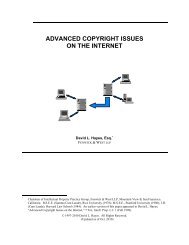International Tax Aspects of Foreign Currency Transactions
International Tax Aspects of Foreign Currency Transactions
International Tax Aspects of Foreign Currency Transactions
You also want an ePaper? Increase the reach of your titles
YUMPU automatically turns print PDFs into web optimized ePapers that Google loves.
sale at the leg-in date, and deferred until the maturity or disposition<strong>of</strong> the DI.(c)If a hedge <strong>of</strong> DI or executory contract is terminated beforematurity, the taxpayer is deemed to have “legged out” <strong>of</strong> thehedge. Both sides <strong>of</strong> the transaction (not just the leg actuallydisposed <strong>of</strong>) are deemed disposed <strong>of</strong>, and the net gain or loss isrecognized on that date.(i)(ii)In TD 9598 (Sept. 6, 2012), the IRS issued new temporaryregulations clarifying the application <strong>of</strong> the leg-out rules incases where one <strong>of</strong> an interest rate or FX swap wasselectively terminated, where the other hedge remained inplace. In such cases, the taxpayer is deemed to dispose <strong>of</strong>all legs <strong>of</strong> all hedges, as well as the DI, on the leg-out date.Example. TP enters a qualifying DI, interest rate swap, andFX swap and elects integrated treatment. On a disposition<strong>of</strong> the FX swap, the TP’s net gain or loss is determined byreference to the DI, the FX swap and the interest rate swap,and not solely the FX swap and the DI.(d)In the case <strong>of</strong> a hedged executory contract, the hedge must beentered after the executory contract is entered into and before theaccrual date, and must hedge all exposure at least through theaccrual date <strong>of</strong> the payable or receivable. By contrast to the rulesgoverning debt instruments, there is no leg-in on entry <strong>of</strong> a hedgeduring the executory contract period because the exposure on thecontract is otherwise ignored for tax purposes until the accrualdate.(5) Identification rules.(a)(b)<strong>Tax</strong>payer must make a contemporaneous identification <strong>of</strong> theinstrument on the date <strong>of</strong> the hedge when the financial instrumentis entered into that clearly identifies the integrated transaction.IRS discretion to integrate if, based on the facts and circumstances,the transaction “is in substance hedged.” The IRS discretionapplies even if the two instruments are held by different taxpayersand cannot satisfy the requirements for hedge treatment. See Regs.§§ 1.988-5(a)(8)(iii) and 1.988-5(b)(3)(ii).(6) Private letter ruling option (§ 1.988-5(e)).55© 2013 William R. Skinner, Esq.Fenwick & West LLPwrskinner@fenwick.com
















